CLAS242 - The Early Republic Period
1/25
Earn XP
Name | Mastery | Learn | Test | Matching | Spaced |
|---|
No study sessions yet.
26 Terms
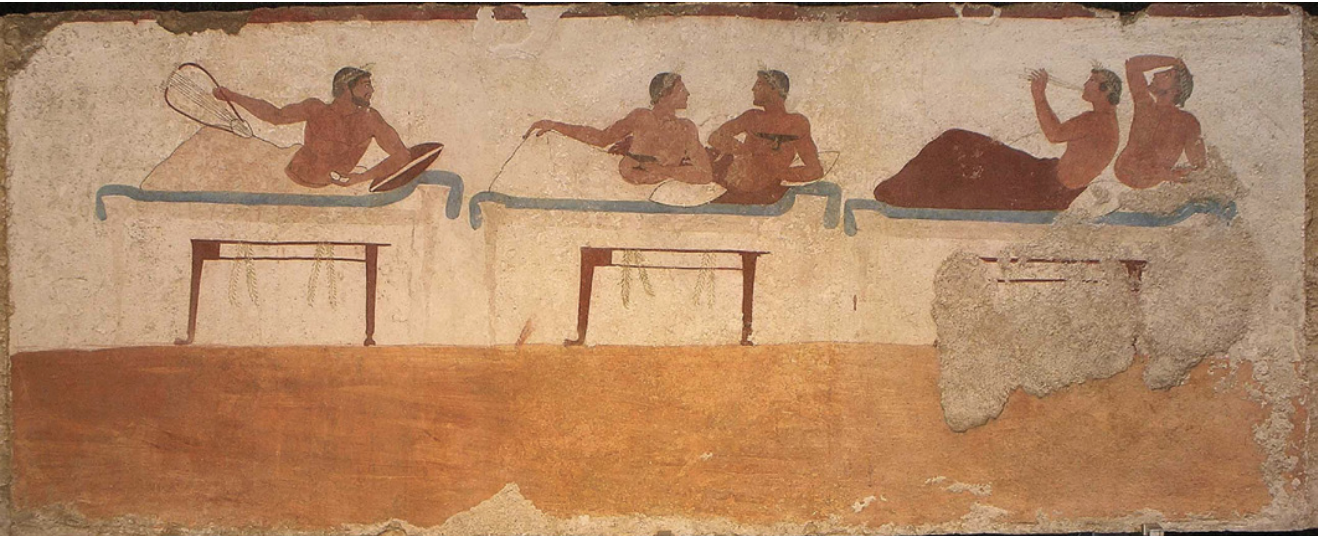
Identify and Analyze
Symposium scene, wall painting in the Tomb of the Diver, Paestum
Early Republic Period
509BE-211BCE
Symposium
Greek elite male drinking party
drink wine, listen to entertainment, sing, or discuss philosophical, cultural, or political topics
homosexual couples of older man + younger man representation
one couple per couch
Lyre
important component of music in symposium
associated with elite male status/identity
lyric poetry sung/lyrics accompanied by the lyre
reinforces elite status of tomb occupant
figures use Greek skin composition
red skin for men white skin for women
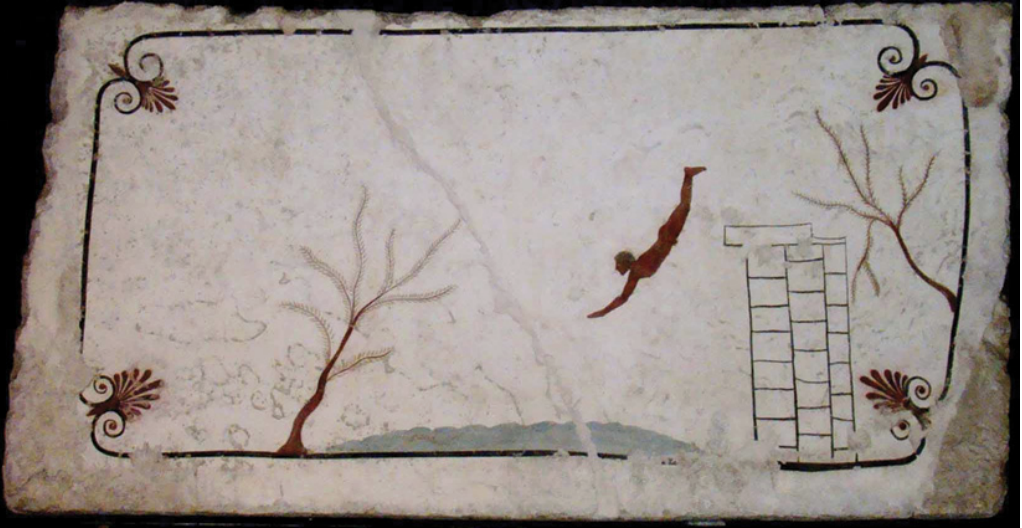
Identify and Analyze
Diver scene from the roof slab, wall painting in the Tomb of the Diver, Paestum
Early Republic Period
509 BCE - 211 BCE
Greek proportions and skin tone
Metaphorical
showing passage from life to death
transference of Greek styles into Etruscan art, but changed to better fit Etruscan culture
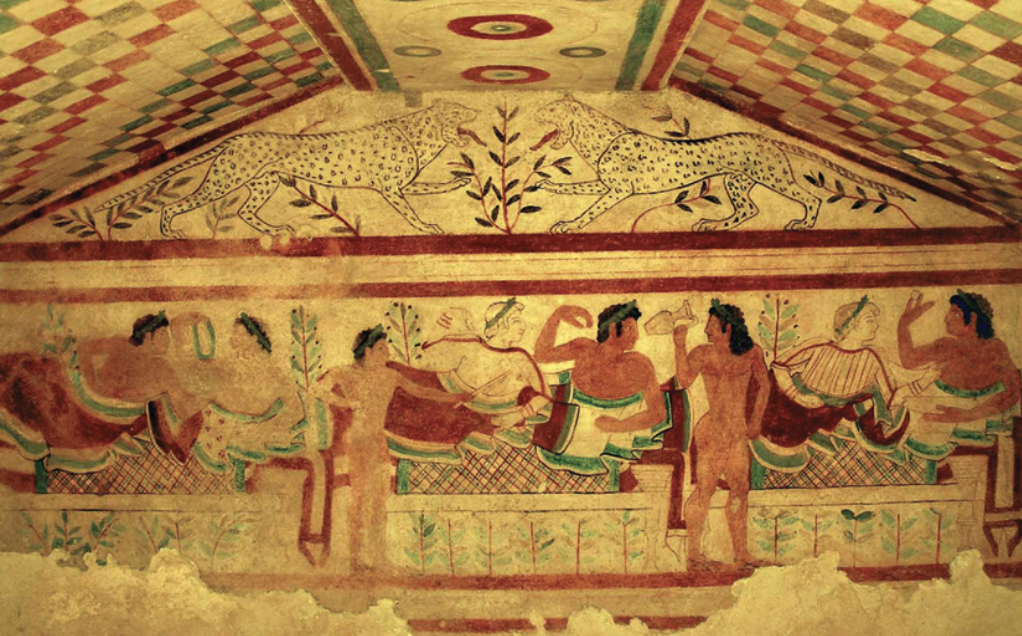
Identify and Analyze
Banquet scene, wall painting in the Tomb of the Leopards, Tarquinia
Early Republic Period
509 BCE - 211 BCE
compositions relies heavily on Greek models
profile faces, blocks of colour, and skin tone
archaic body proportions + garlands indicating a celebration
red lines
forming registers
forming ground line of above panel
Etruscan features:
banquet of male-female couples
hierarchy of scale
Horror vacui
Centre female
possibly male
possibly example of transgender individual in antiquity

Identify and Analyze
Dancers, wall painting from the Tomb of the Triclinium, Tarquinia
Early Republic Period
509 BCE - 211 BCE
influence of Greek archaic artistic style
dancing as worship for Dionysus
part of his celebration
No Dionysus iconography/symbolism representing him in this piece
Etruscan showing of a Greek act
Etruscan features
clothes
long fingers
trees + birds
Greek features
coloured skin tone
profile faces/legs and front torsos
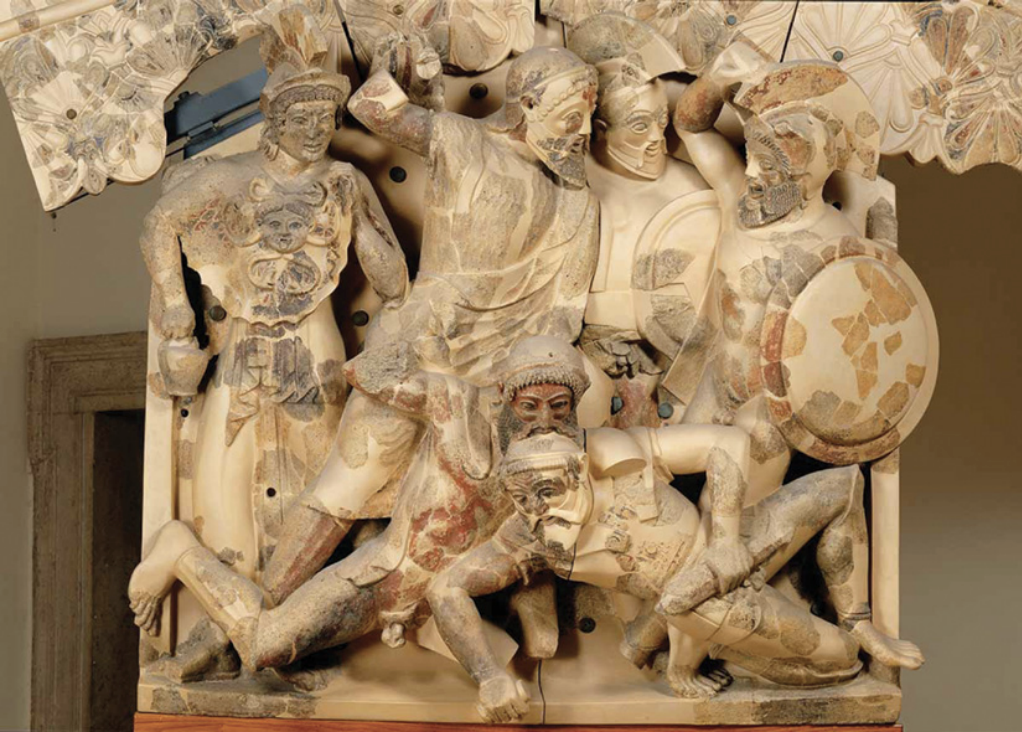
Identify and Analyze
Pediment relief sculpture from Temple A, Pyrgi
Early Republic Period
509 BCE - 211 BCE
Pedimental
relief within top triangle front piece at top of temple
usually never a historical event and purely mythological
historical event tends to date the temple and set it in one time period
Use of myth is allegorical
to send a message
painted terracotta
Pyrgi
major battle between Greeks, Carthaginians, and Etruscans
Etruscans lost so to appease the Gods they built this temple in Pyrgi as a gift to them
Obviously had no favour from the gods because they lost so they needed to gain it back
Greek myth of 7 princes
7 princes of Thebes, a city-state, all banished from it
They come back for revenge
7 gates for 7 princes
one prince per gate
Top Row
Minerva on proper right
Aegis cloak + helmet
Jupiter second from proper right
arm raised to spear Keraunos with his lightning bolt
Bottom Row
battle of Tydeus and Melanippus
Tydeus eating the brain of Melanippus
act revokes his promise of eventual Godhood
cannibalism NEVER shown in Greek art
Message to Greeks: don’t mess with us(?)
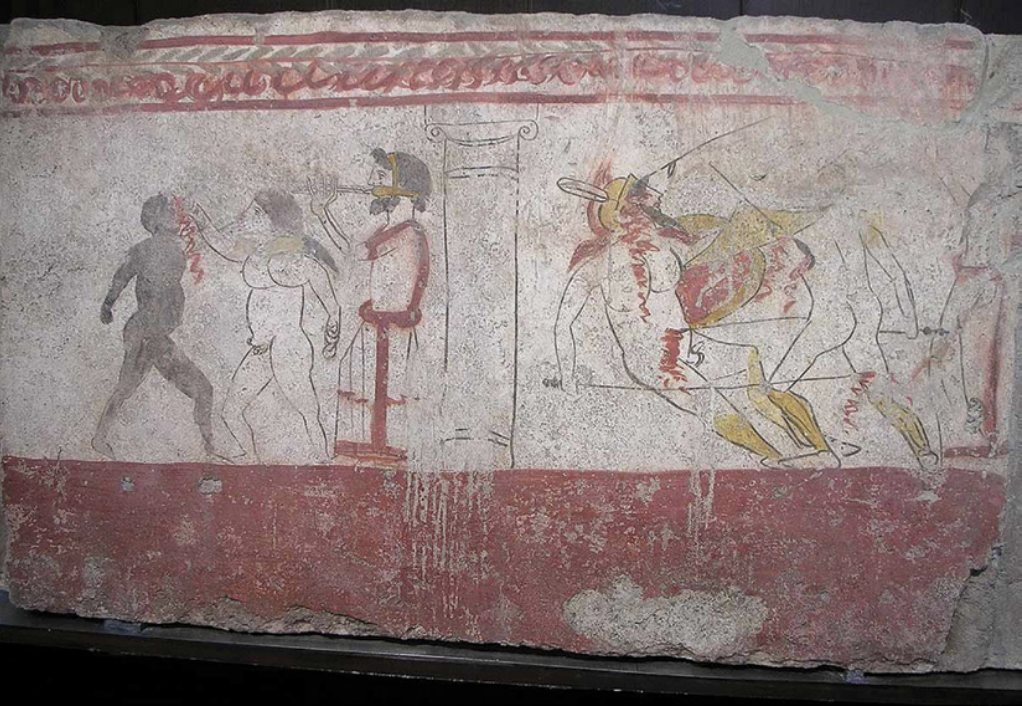
Identify and Analyze
Funerary games of boxers and gladiators, wall painting from Tomb 90a, Paestum
Early Republic Period
509 BCE - 211 BCE
funerary painting tradition carries on into 4th century BCE
Boxing + Gladiator Fight
Blood as a sacrifice to chthonic deities
spilt over deceased’s tomb to ease passage
blood being drawn not a primary thing in funerary games
only later in Roman times does it become more important
Not necessarily killing someone but rather just first blood
New Etruscan idea
Turning death into a spectacle
joy of the spectacle warding off death

Identify and Analyze
Funerary games of charioteers, wall painting from Tomb X, Paestum
Early Republic Period
509 BCE - 211 BCE
chariot racing as a funerary game
Greek culture adopted by Lucanians
Ritual
garland around column, garlands in space above the horses
taking it into realm of religion/mythology/not reality
pomegranate
associated with death and rebirth
the rape of Persephone
all lead to funeral ritual iconography
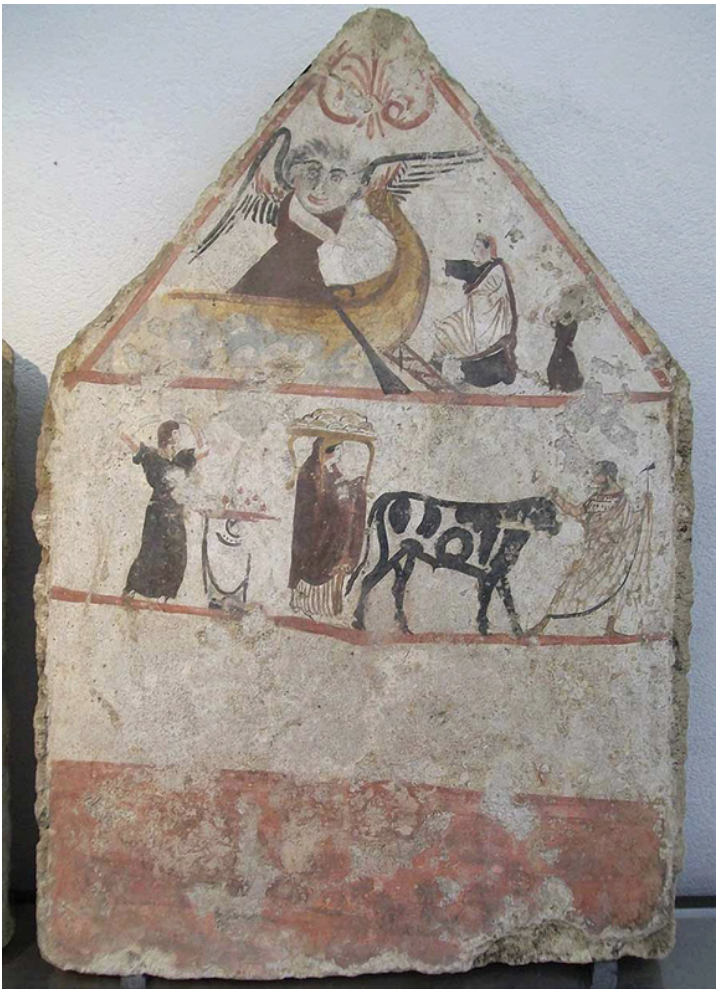
Identify and Analyze
Scenes of woman’s funeral and travel into the underworld, Paestum
Early Republic Period
509 BCE - 211 BCE
Funerary Stella
big painted rock/tombstone
Dado
painted in red at bottom register
the lower portion of the wall of a room, distinctly painted with panels/contrasting colours
Below Panel
Aspects of Funeral
left woman - pulling her hair out in grief
middle women - tables of loaves of bread and food as a sacrifice on their heads
right man - priest
Cow sacrifice
man with a hammer to stun the cow before slitting it’s throat
Above Panel
Little girl + older woman
mother bringing daughter to safe passage? both going together?
Vanth
winged, female Etruscan. chthonic figure
Psychopomp: deity/spirit that brought spirits across the river
resembles Gorgon with wings and big head
Apotropaic image
so scary in order to ward off evil
show of mixture of Greek and Etruscan imagery in Lucanian culture
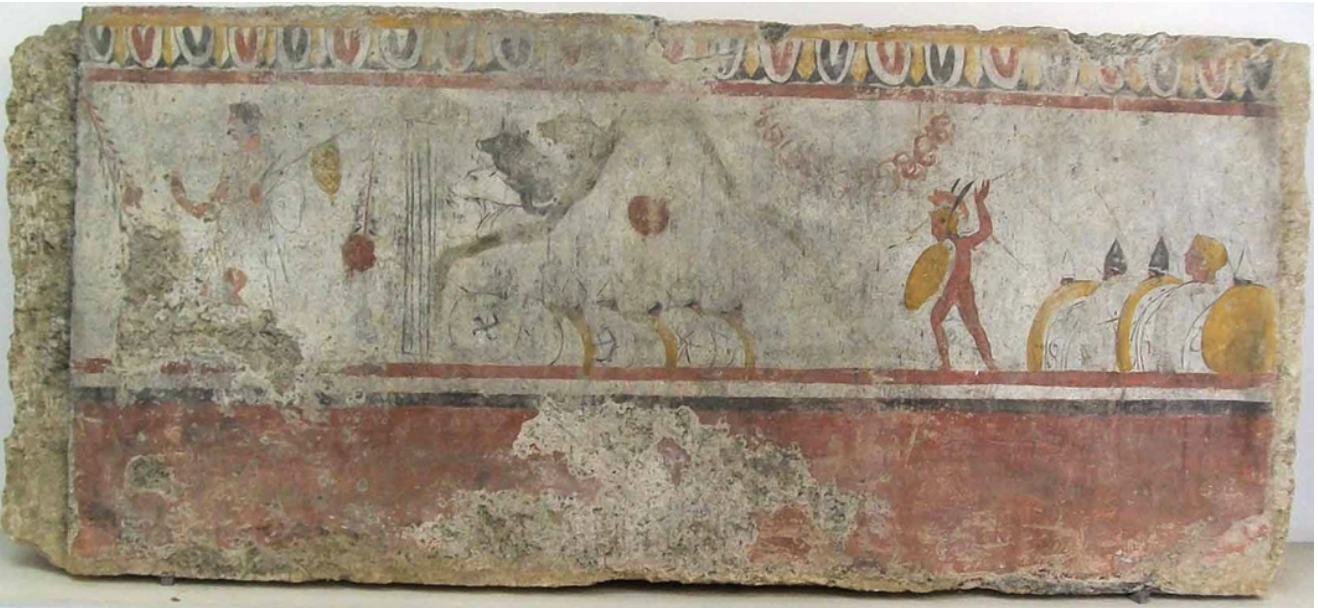
Identify and Analyze
Historical battle, tomb painting from Tomb 114, Paestum
Early Republic Period
509 BCE - 211 BCE
Lucanian Tomb Painting
Greek arête, Latin virtus
men often celebrated through paintings of evidence of their masculine excellence
Lucanian word unknown
Moment prior to battle
left - army lined up with shields in formation
middle - mountain with cows behind it
right - another army ready to fight
Right figure
stands out against the rest
hierarchy of scale
facial features
helmet
Figure in front of army
Naked except for Lucanian helmet
holding up spear
Mars leading them?
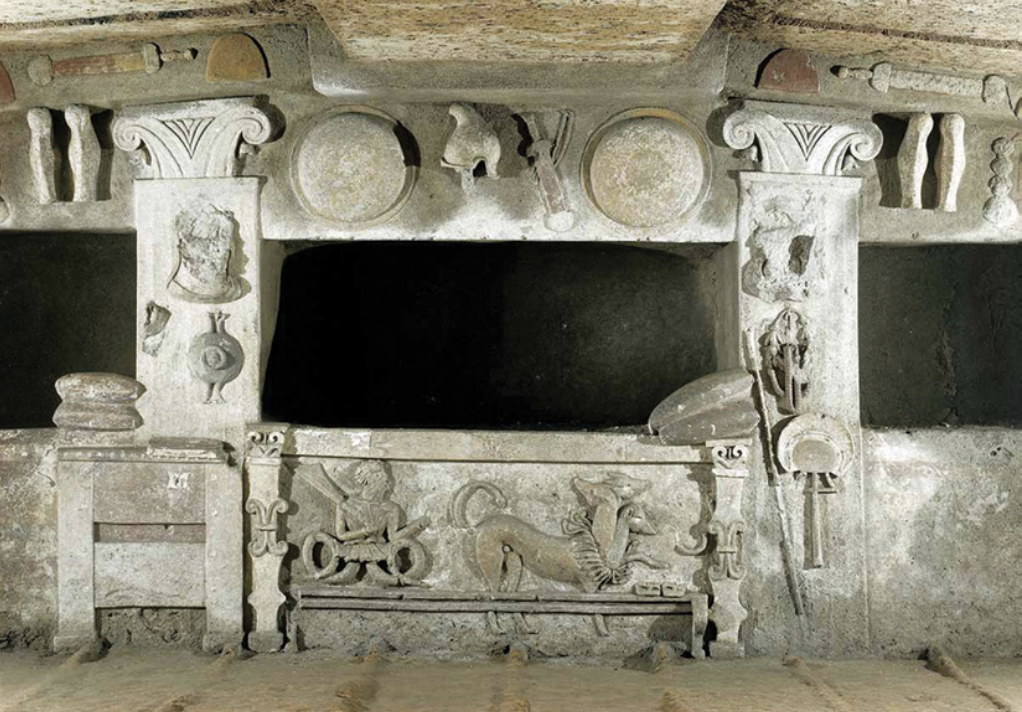
Identify and Analyze
Carved and painted reliefs, Tomb of the Reliefs, Cerveteri,
Early Republic Period
509 BCE - 211 BCE
Change in subjects
from banquets and festivities
celebrating life
to darker themes
mourning death
Reliefs of Charun and Cerberus
emphasis on chthonic creatures
Reliefs of Helmets and Shields
helmets, shields, greaves, and swords
high status of a male
military
Painted terracotta columns
filled with images of household items
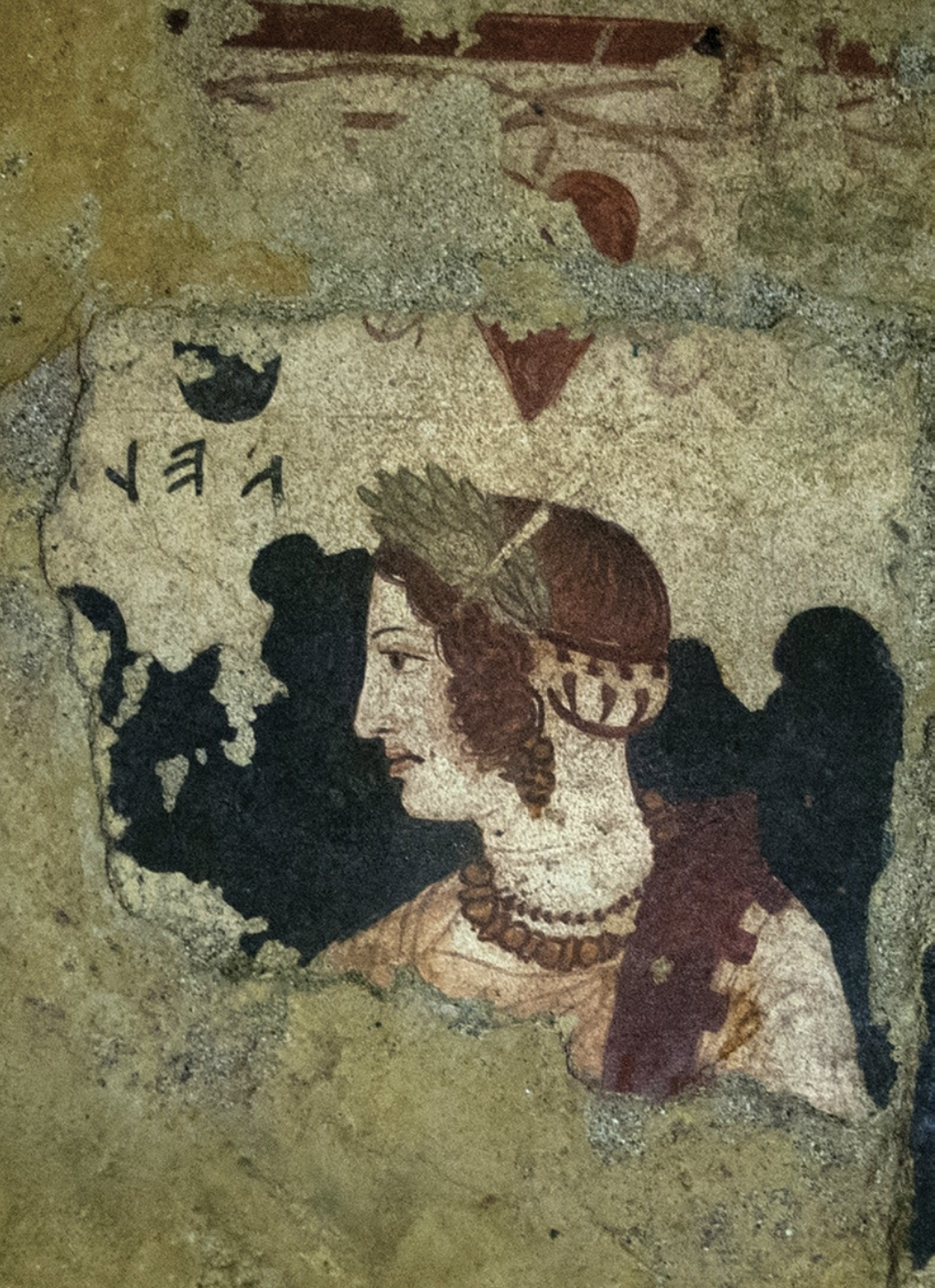
Identify and Analyze
Portrait of Velia, tomb painting, Tomb of Orcus, Tarquinia
Early Republic Period
509 BCE - 211 BCE
Velia
name written backwards as if image was speaking straight to you
Very Decorative
detailed + intricate necklace
egg and dart style
clothing with tassles
hair up in back with hair piece
laurel
intricate curls
lipstick and eyeliner
sense of individual
very strong profile
showing specifics - not idealized
Profile Eye
no longer unrealistic front eye with profile face

Identify and Analyze
Banqueting couple, wall painting from the Tomb of the Shields, Tarquinia
Early Republic Period
509 BCE - 211 BCE
Hierarchy of Scale
people seated are bigger than musicians, showing importance
Names written backwards
as if people in the painting are speaking to you
¾ Head Turn
Profile Eye
Intricately decorated couch
Etruscan style
Woman’s breasts
covered by see through fabric
showing of shape and nipples
very rare until later Roman times to show naked women
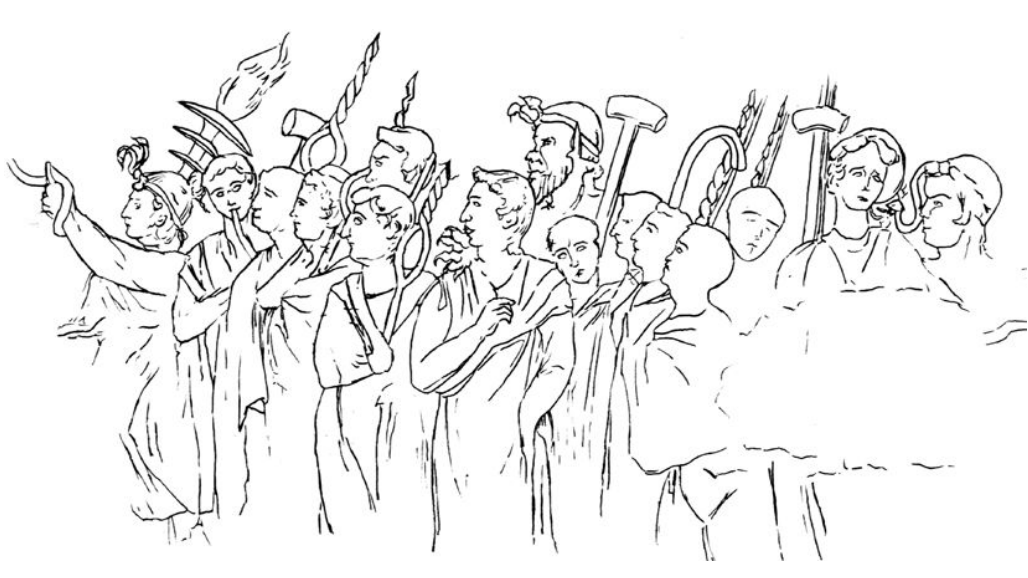
Identify and Analyze
Processional scene, Tomb of the Typhon, Tarquinia
Early Republic Period
509 BCE - 211 BCE
two reasons from line drawing version
painting is very deteriorated (reconstruction)
archaeologist who discovered it owns publishing rights
has yet to release actual image
Processions
seen in later Roman art
all different kinds
Tomb context - funeral procession
into afterlife or to the funeral itself
Instead of Hierarchy of Scale
background figures raised above others
looks like they’re taller, but only to show everyone/so no one is covered
Mixture of Real Life and Mythological Creatures
two possibilies
as part of funeral
people dressing up as chthonic deities/ancestors
actual demonic figures
ghosts physically present?
not demonic in a negative sense - only as “from the underworld”
Leader of Procession
most likely the deceased in question
Magistrate clothing
torch and hair band
maybe was genuinely a magistrate
maybe put in these clothes to show importance or status

Identify and Analyze
Tomb of Q. Fabius, wall painting from a tomb on the Esquiline Hill, Rome
Early Republic Period
509 BCE - 211 BCE
Due to names on paintings, very inclined to believe this is the tomb of Quintus Fabius Maximus Rullianus
Two names in tomb paintings:
Fabius
known Roman General who won against the Samnites
elected consul 5 times between 322 - 295 BCE
Fannius
the Samnite
a people from Italy
Depicted in being defeated by Fabius during second war against the Samnites
Episodic Narrative
various panels of story telling, like a comic strip
an advanced technique of story telling
key is to show same people in different scenes
through different times and places
this is what makes it “episodic”
later becomes Roman standard of representing stories

Identify and Analyze
Statue of Mars from Todi
Early Republic Period
509 BCE - 211 BCE
Bronze Statue
first Etruscan example of a bronze statue
thought to be more abundant, but were later pilgrimaged throughout the years to be melted down and used for other things
90% copper, 10% tin
Copper could be found EVERYWHERE in Europe
Greek word for copper very close to “Cyprus”, which was filled with a bunch of copper and hence named for it
Tin - absolutely none
originally thought they were getting it from modern day Afghanistan where there’s lots
found in Cornwall, England
trade route between the two established far earlier than originally thought
no evidence of it being Mars
rather just a warrior
Patera
held in right hand
associated with sacrifice
filled with olive oil/wine/blood then poured as offering to the gods
in held in hand - religious context
as you’re actively giving it out as an offering
Cuirass
Etrusco-Italic breastplate
very typically made of hardened bits of leather that were sewn together
metal plates at bottom as skirt to reinforce abdominal area
Contrapposto
very Greek
“counterpose/counter posture”
weight put all on one foot with opposite leg bent, hips and shoulders tilted to adjust for weight distribution
meant to show natural movement of humans
Bronze Casting
1 - create a core
2 - layer of wax to cover core
3 - place mould of terracotta over wax
4 - heat up
“Lost Wax Method”
wax melts away to leave a perfect negative in the mould
5 - Bronze poured in
6 - Bronze Statue
7 - Finishing work
buffing
additions in copper
lips, eyebrows, nipples, pubic hair
additional inlays
shells/glass
could be painted
used as whites of eyes
ivory/copper teeth
Segmented Casting
body parts made separately
weight + caution factors
People could then come in and pick/choose parts to add to the statue they wanted
richer men could commission from scratch since they could afford that
paintings of statue makers workshops as evidence
bronze heads + feet hanging on the walls in the background
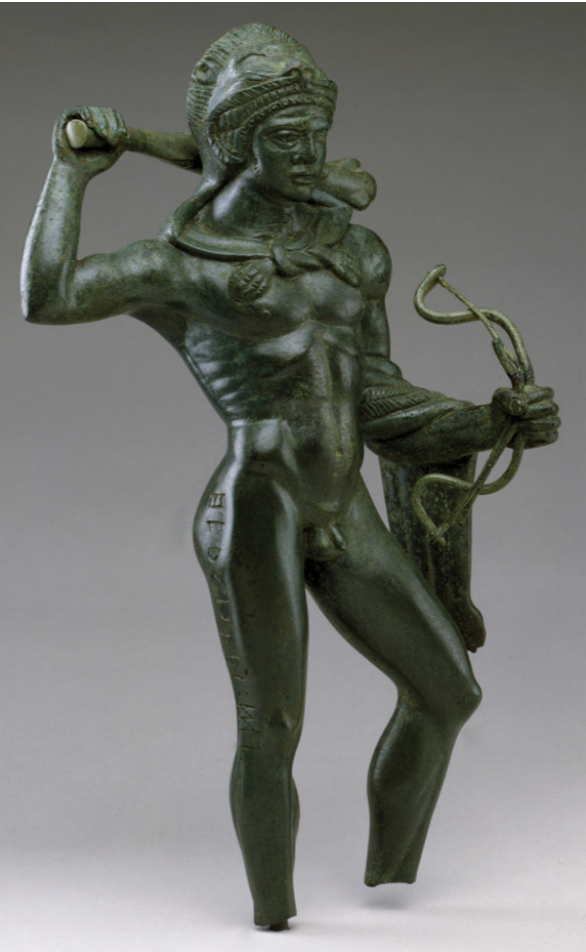
Identify and Analyze
Bronze statuette of Hercules, probably from Cerveteri
Early Republic Period
509 BCE - 211 BCE
Votive
object of devotion
few inches tall
given to Gods as offering when going into the temple
usually cast images of the gods themselves
sold outside temples by vendors
More permanent materials like bronze and terracotta
increasing wealth?
increasing devotion?
or desperation of Etruscans as Romans took over their lands
appealing to the gods for their favour
Hercules
lion skin, club, and bow
nudism = heroism
Contrapposto
Greek
Patterning and Rib Detail
Etruscan

Identify and Analyze
Ficoroni Cista, Praeneste
Early Republic Period
509 BCE - 211 BCE
Cista
a specific kind of jar
meant for toiletries
comb, hair pins, mirrors, cosmetics, etc.
associated with marriage
Cast segmently
Lid/Lions feet/Figures on top are all separate
3 Figures
Dionysus + Satyrs
Domestic Gods
associated with marriage processions
Inscribed Sphinxes
near Eastern influence
Jason + Argonauts Scene
Golden Fleece + Medea
all greats heroes on the same voyage
Amycus
ruler of the country of the Bebryces
Had to be beaten in boxing match in order for Argonauts to drink from his fountain
Pollux defeats him
Greek “Boxing”
more of a blood sport
fight until someone gives up/someone can’t fight anymore
“Gloves” - hardened straps of leather wrapped around hands
Novius Plautios
artist signed his name on it
Famous Greek painting by Mikon of same scene, lost, 5th cent bce
came to Rome - possibly that Novius copied this painting?
simply shows influence of Greeks on Romans/Etruscans
Dindia Macolnia
inscribed name “gave me to her daughter”
the woman who commissioned it for her daughter
Might represent a woman of elite status
Gives insight into what kinds of things women would commission
Plus sense of dowry, capabilities/wealth of women
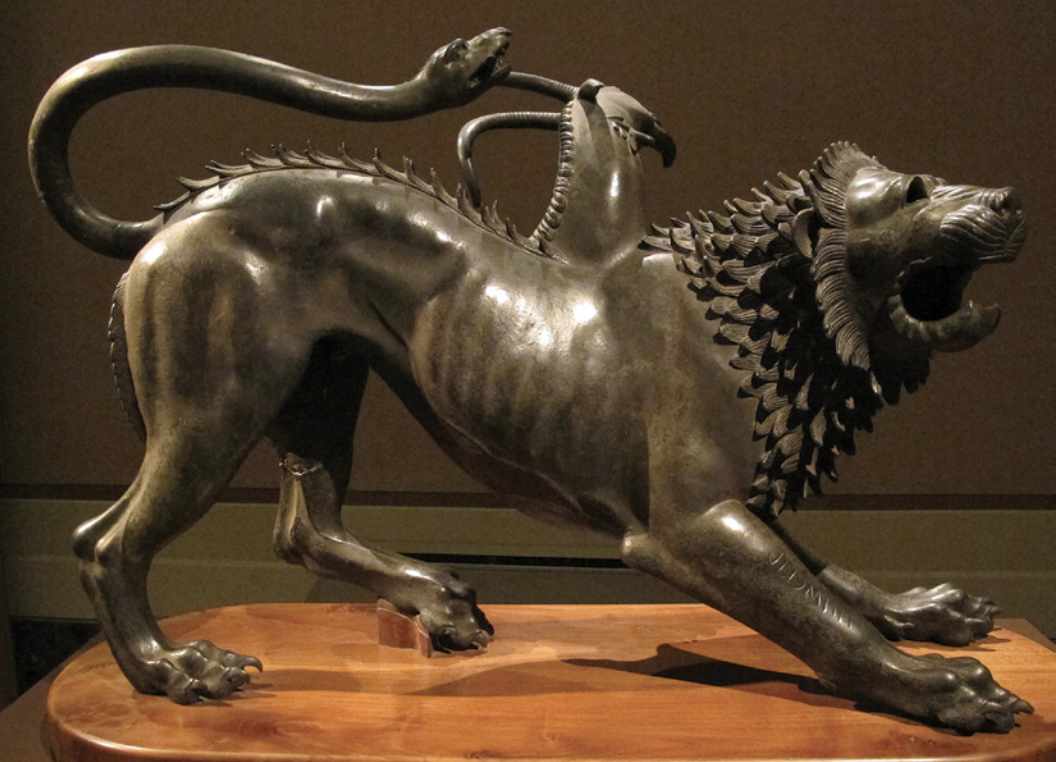
Identify and Analyze
Bronze chimera from Arezzo
Early Republic Period
509 BCE - 211 BCE
Chimera
monstrous mixture of different animals into one
Antiquity definition - Snake as tail, lion’s head, ram’s body
Contemporary definition - used to describe a group of proteins because they're so warbled
Example of metal-working skill of Etruscans
Votive Offering
Inscription on side that meant "To the Gods"
Very expensive- came from someone wealthy
Bellerophon
Rides Pegasus
One of his major fights was slaying the chimera
Idea that 3 heads are looking up at Bellerophon in the sky on Pegasus
Snakes, Lions, and Rams/Goats common in Italy
Smaller lion in Italy but was hunted to extinction around 4th cent bce
So lion image probably from near east
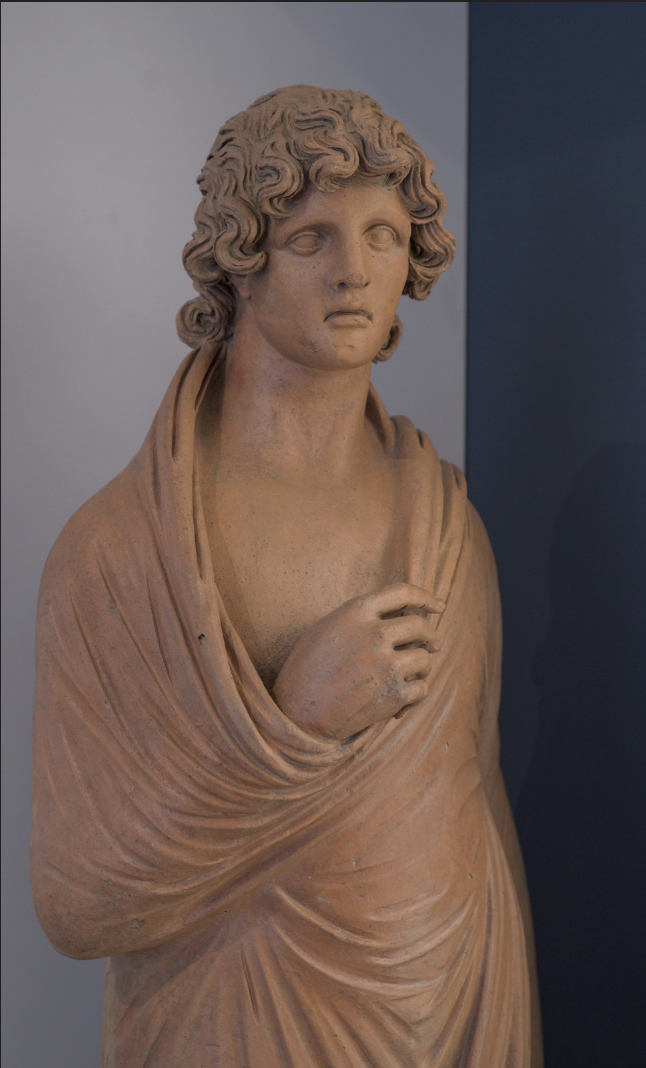
Identify and Analyze
Terracotta statue of a man, Cales
Early Republic Period
509 BCE - 211 BCE
Illustrates connection between Greece and Rome
Face and hair – could very easily be inspired by Greek statue
Eastern mediterranean style
Most famously in portraits in alexander the great
Though happened before and after him
More expression than Apollo of Veii or other early/at the same time
Roman Toga
Represents wealth, nobility, depending on colour painting – could've been a magistrate
Not just a piece of clothing but what the cloth symbolizes
Greek world - would’ve been nude
Cultural coding of what a man should be
Proud of Roman-ness
Working
Generic ideal
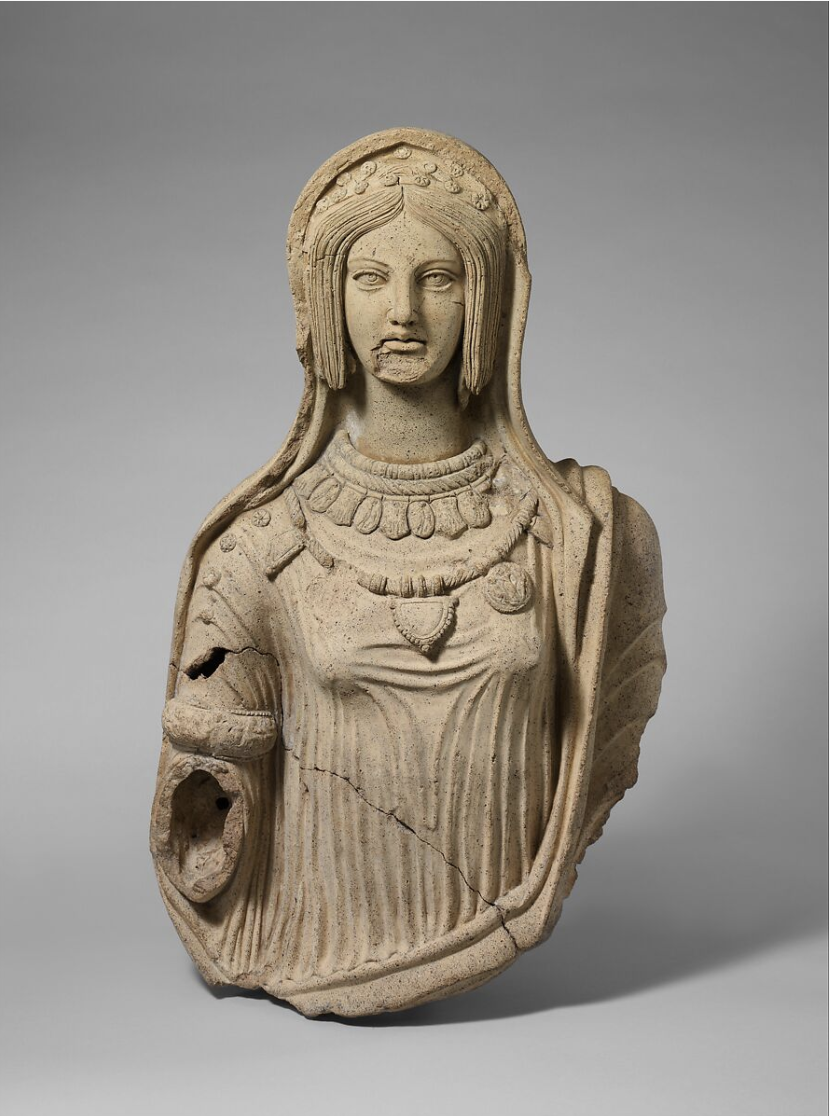
Identify and Analyze
Terracotta votive statue of a woman, Lavinium
Early Republic Period
509 BCE - 211BCE
Cultural coding of what a woman should be
Incredibly decorated
Multiple necklaces, intricate breastplates, elaborate hairstyle, huge earrings, elaborate dress
Head covered – religious context
Priestess? A woman engaging in ritual?
Representing the role of a woman in society
Pious, decorus, show off wealth, adornments in lots of different ways

Identify and Analyze
Bronze bust of a man “Brutus”
Early Republic Period
509 BCE - 211 BCE
Portraiture
Etruscans and Roman inspired to present more realistic portraits
More than Greeks/Eastern
Showing of idealism
Finest example of Etruscan portraiture that we have
In depth idea of not only what they look like but who they are
A sense of personality
Conveyed through the physical
No evidence of who this person truly is
Why people say it represents Brutus
The one who kicked out the last Etruscan kings
Showing of age
Wrinkles, prominent nasal labial lines (smile lines), beard (maybe), eye bags, crow's feet, slight jowls,
Neck + robe added later in 16th century
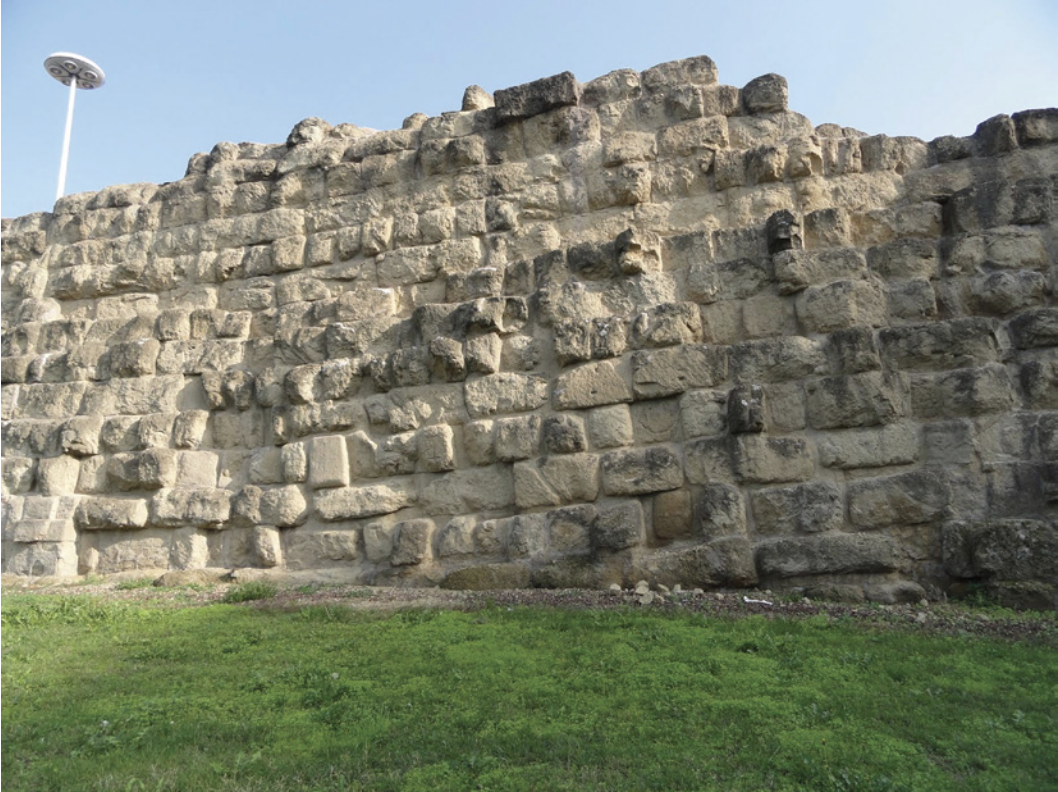
Identify and Analyze
“Servian Wall,” Rome
Early Republic Period
509 BCE - 211 BCE
First major wall to be put up all around city of Rome
Rome not biggest city in population or size, yet this was the biggest wall built in the mediterranean
Massive building project
Very old, gets replaced often
Only few places to see bits of the wall preserved
Purpose
Marks extreme territory of Rome
Build house outside of the walls? You're not roman anymore
Defense
Religious separation
Pomerium
Ditch around inside the wall
Spiritual limits of the walls
Most important
Gods reside on the inside
Outside Gods to come to Rome had to have temples on outside of Rome
Isis, big cult following in Rome, but temples were outside
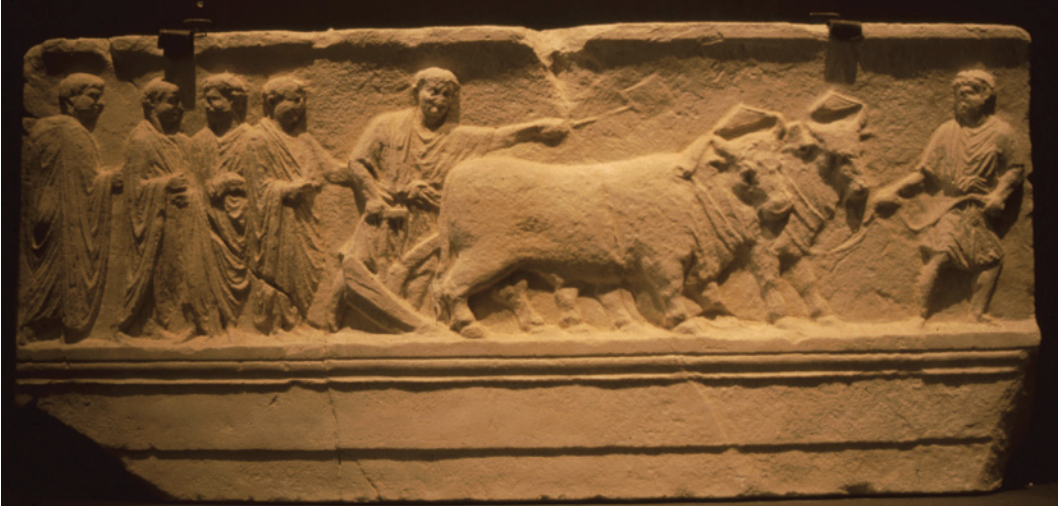
Identify and Analyze
Limestone relief of sulcus primigenius for a Roman colony
Early Republic Period
509 BCE - 211 BCE
Cattle plowing the ditches
Religious important ceremony of making of the pomerium
Would do this for any major settlement
You have a villa? Dig a tiny pomerium
Roman Military Camps – pomerium
All to appease the Gods
Gods are with us – this is where the reign goes to

Identify and Analyze
Ostia, plan of Roman colony centered on forum
Early Republic Period
509 BCE - 211 BCE
Shows where pomerium was
First example/attempt of city/urban planning?
West coast of Italy
Strategically important
Right next to a harbour
Also where the Tiber flows out into Mediterranean
Defensive position to guard the mouth of the Tiber
Eventual entry into Rome if enemies were to take it in
Main roads, houses coming off of them, main areas deisgned to be non-domestic (Forum, Temples, Amphitheatre etc.)
North South East West road – two roads entering each other
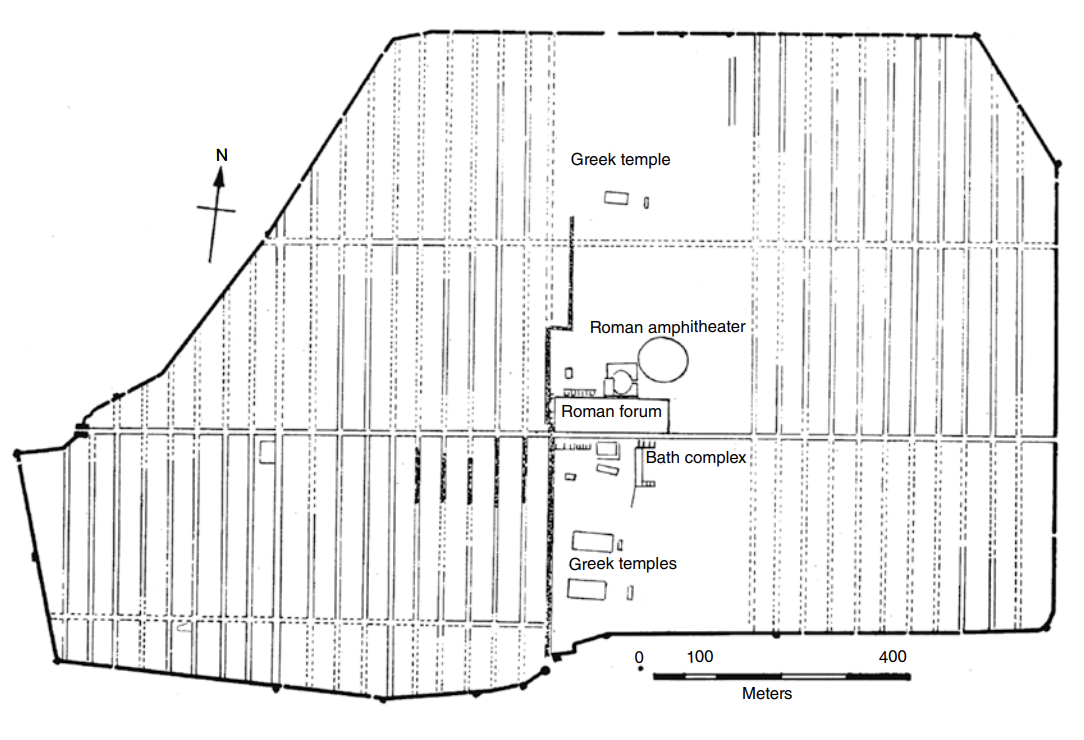
Identify and Analyze
Paestum, plan of Roman colony
Early Republic Period
509 BCE - 211 BCE
Orthogonal plan
"straight"/grid plan
Originally called Hippodamian plan
Hippodamius first to come up with this
Not true, 5th century bce when he was alive but first example was Egyptian and long before him
Maybe he popularized it
Very like New York
Everything neat and tidy
Decumanus – east-west street
Decumanus Maximus – main east-west street
Where intersection with cardo maximus will be major happenings – town square/Forum
Cardo – North-south street
Cardo Maximus – main north-south street
Where intersection with decumanus maximus will be major happenings – town square/Forum
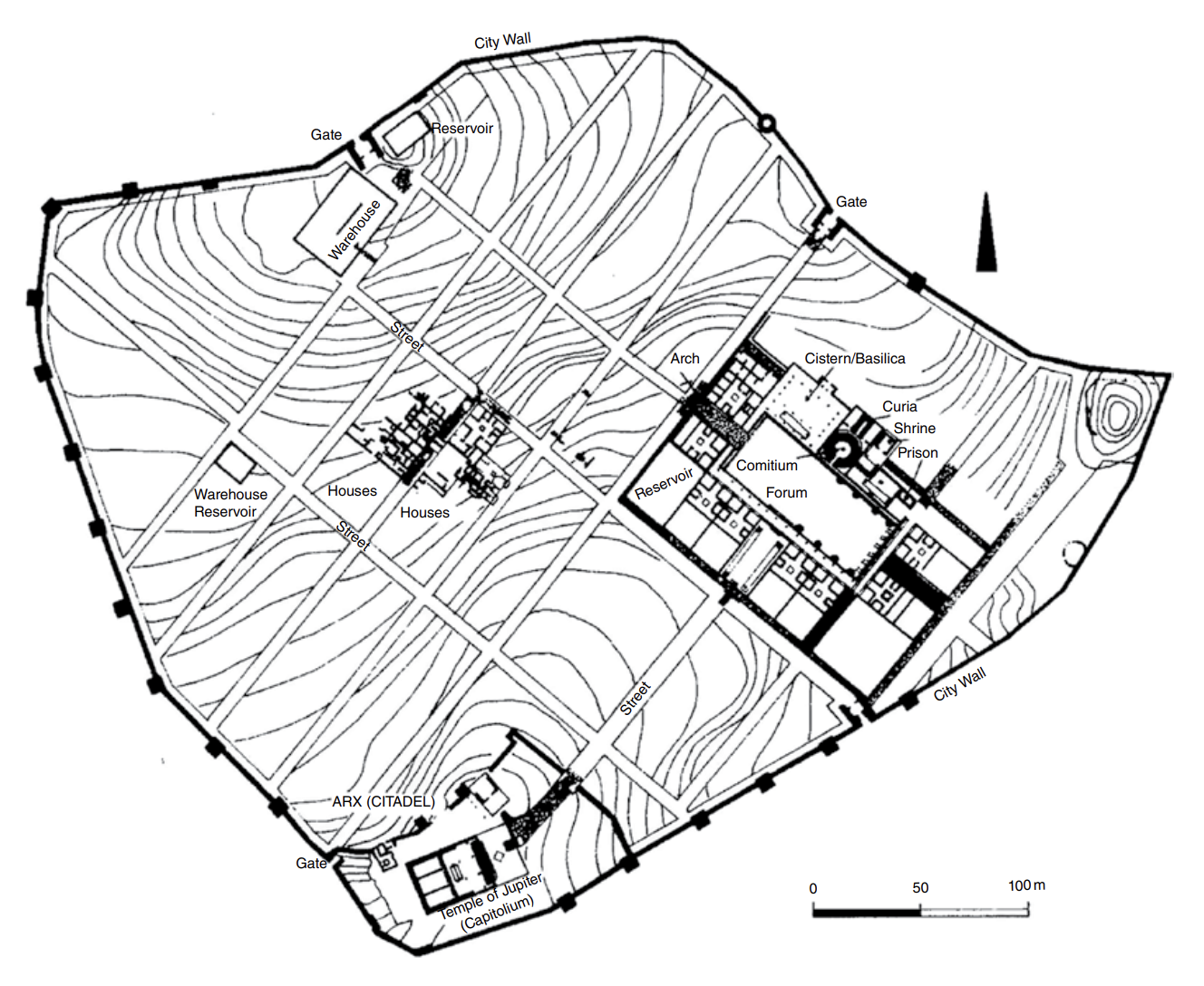
Identify and Analyze
Cosa, reconstruction drawing of arx dominated by their Capitolium
Early Republic Period
509 BCE - 211 BCE
North/South/East/West gates will mark ends of the decumanus and cardo
Old greek colony – becomes a Mini Rome
Many buildings look like Rome buildings
Southern corner
Garnered lots of attention
Mini hill
Imitate one of seven hills of Rome
Placed a temple to Jupiter Capitallinus
Capitalinus – just means who is Optimus Maximus one
Also includescapitalline triade
Just foundation survives now